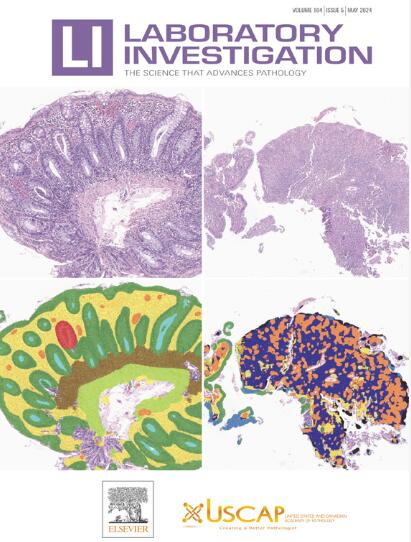跨多个空间尺度评估肿瘤免疫景观,以区分转移性非小细胞肺癌的免疫疗法反应。
IF 5.1
2区 医学
Q1 MEDICINE, RESEARCH & EXPERIMENTAL
引用次数: 0
摘要
基于免疫检查点抑制剂(ICI)的疗法已在程序性死亡配体1(PD-L1)高表达的非小细胞肺癌(NSCLC)患者中显示出良好的疗效,但并非所有患者都对疗法有反应。肿瘤微环境(TME)具有复杂性和异质性,因此了解影响治疗反应的关键药物和特征具有挑战性。在本研究中,我们利用多重荧光免疫组化技术(mfIHC)来定量评估肿瘤和免疫细胞之间的相互作用,从而找出肿瘤微环境在多个空间水平上发生的模式。为此,我们针对 52 名转移性 NSCLC 患者的 1269 张 mfIHC 图像数据集引入了几种新颖的计算方法。通过空间 G-cross 功能,我们量化了整个图像层面的细胞相互作用程度,我们发现在 ICI 反应者中,细胞毒性 T 细胞 (CTL) 和辅助性 T 细胞 (HTL) 与上皮肿瘤细胞 (EC) 的活性显著增加(p = .022 和 p < .001,分别为 p = .022 和 p < .001),而与非反应者相比,T 调节细胞 (Treg) 与 EC 的活性降低(p = .010)。通过利用空间重叠方法,我们定义了肿瘤亚区(我们称之为肿瘤 "外围"、"边缘 "和 "中心"),并发现了影响阳性反应的更多局部免疫-免疫相互作用,包括 CTL 和 HTL 与这些亚区的抗原呈递细胞(APC)之间的相互作用。最后,我们训练了一个可解释的深度学习模型,该模型确定了对反应分类影响最大的关键细胞区域(AUC = 0.71±0.02)。评估这些亚区域内的空间相互作用进一步揭示了在整个图像水平上并不显著的新见解,特别是在应答者群体中,APCs 和 Tregs 相互关联度的提高(p = 0.024)。总之,我们证明,通过多层次的空间分析来阐明细胞组成和相互作用的模式,可以提高我们对TME的认识,更好地区分患者对免疫疗法的反应。本文章由计算机程序翻译,如有差异,请以英文原文为准。
Assessing the Tumor Immune Landscape Across Multiple Spatial Scales to Differentiate Immunotherapy Response in Metastatic Non-Small Cell Lung Cancer
Although immune checkpoint inhibitor-based therapy has shown promising results in non-small cell lung cancer patients with high programmed death-ligand 1 expression, not all patients respond to therapy. The tumor microenvironment (TME) is complex and heterogeneous, making it challenging to understand the key agents and features that influence response to therapies. In this study, we leverage multiplex fluorescent immunohistochemistry to quantitatively assess interactions between tumor and immune cells in an effort to identify patterns occurring at multiple spatial levels of the TME. To do so, we introduce several computational methods novel to a data set of 1,269 multiplex fluorescent immunohistochemistry images from a cohort of 52 patients with metastatic non-small cell lung cancer. With the spatial G-cross function, we quantify the degree of cell interaction at an entire image level, where we see significantly increased activity of cytotoxic T cells and helper T cells with epithelial tumor cells in responders to immune checkpoint inhibitor-based (P = .022 and P < .001, respectively) and decreased activity of T-regulatory cells with epithelial tumor cells compared with nonresponders (P = .010). By leveraging spatial overlap methods, we define tumor subregions (which we call the tumor “periphery,” “edge.” and “center”) and discover more localized immune-immune interactions influencing positive response, including those between cytotoxic T cells and helper T cells with antigen presenting cells in these subregions specifically. Finally, we trained an interpretable deep learning model that identified key cellular regions of interest that most influenced response classification (area under the curve = 0.71 ± 0.02). Assessing spatial interactions within these subregions further revealed new insights that were not significant at the whole image level, particularly the elevated association of antigen presenting cells and T-regulatory cells with one another in responder groups (P = .024). Altogether, we demonstrate that elucidating patterns of cell composition and interplay across multiple levels of spatial analyses can improve our understanding of the TME and better differentiate patient responses to immunotherapy.
求助全文
通过发布文献求助,成功后即可免费获取论文全文。
去求助
来源期刊

Laboratory Investigation
医学-病理学
CiteScore
8.30
自引率
0.00%
发文量
125
审稿时长
2 months
期刊介绍:
Laboratory Investigation is an international journal owned by the United States and Canadian Academy of Pathology. Laboratory Investigation offers prompt publication of high-quality original research in all biomedical disciplines relating to the understanding of human disease and the application of new methods to the diagnosis of disease. Both human and experimental studies are welcome.
 求助内容:
求助内容: 应助结果提醒方式:
应助结果提醒方式:


